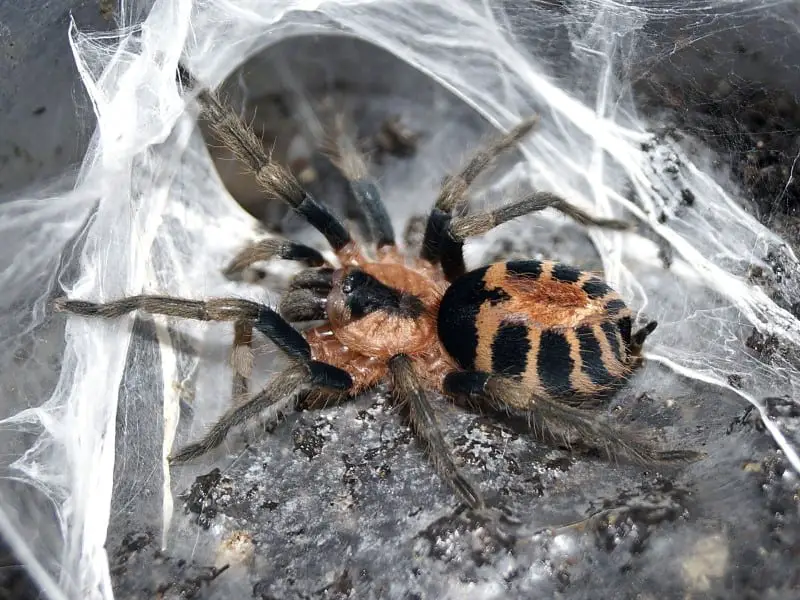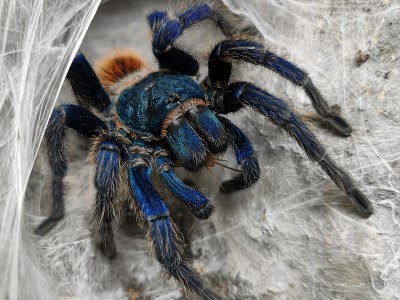In general, spiders do not move a lot. Not unless they really have to.
But what exactly will they do if they have been chased away from their web, or if their web has been destroyed? Will they go back to their web or simply set out on searching for a new place to live?
Do spiders go back to their webs? Generally, spiders will go back to their web if they can reach it, and the area has been offering good access to food and water. However, many spiders may not go back to the same web if they cannot reach it or if they do not feel safe in it.
If you own a pet spider or just happen to find a spider in your home and want to chase it away without killing it, you need to consider some important details first. So let’s take a more in-depth look.

Do Spiders Return to Their Webs?
Spiders make their webs in places where they think there is food. There are more than 45,000 species of spiders, so the places where spiders will make their web will vary greatly.
- Many spiders will make their web over water, between tall grass blades, tree branches, near light sources, and other areas where more insects can be found.
- Trap-door spiders create small burrows underground. They seal the entrance of their burrows with silk, which acts as a trapdoor. When prey passes near the trapdoor, the spider will quickly come out and grab it.
- Diving bell spiders weave their webs underwater in which they trap air bubbles and live.
- Some spiders do not even make webs, so they will not even have anything to return to.
The number one priority for spiders is survival. And survival means fairly consistent access to food and water. Because of this many spiders will return to their web. However, they may not return to their web if they cannot get to it.
Spiders may not exactly have the same concept of a “home” that we have. They will just be attracted to areas that seem favorable in terms of food and water availability. If a spot has good humidity and moisture levels, temperature ranges, and good food access, then it is only natural for a spider to return to it again as it can still offer the same benefits.
Even if you take the spider and throw it outside, it will again seek shelter following the same principles it did in the first place. It will seek places where it can live; it will seek shelter, warmth, and areas that are not occupied by other spiders, which means the spider can end up returning to the same area unless it has been left a long-distance away.
A spider can return to the same web or place because it may possibly remember where it was located.
Researchers believe that spiders do have memory. They found that spiders will remember the features and quantity of the prey they have caught.
So it may not be a stretch to consider that spiders may also be capable of remembering where their webs are located since they will remember where its food was located as well. Because of this, a spider may keep coming back to the same spot even if it was dropped several hundred feet away.
Do Spiders Leave Their Web?
Even though a spider may leave its web, it will usually remain fairly close to it and leave only if it really has to.
Spiders can occasionally leave or even abandon their webs. Male spiders are known to leave their web while searching for a suitable mate, while female spiders will prefer to remain near their web.
During periods of severe lack of food, some spiders may leave their web in search of food. That being said, some spiders (like the orb-weaver, for example) can consume their web as it can provide them with some proteins before relocating. Sometimes they can return at a later time and build their new web in roughly the same spot.
How often a spider may be likely to leave its web and relocate can also be influenced by how much energy is required to rebuild it. Experts have found that spiders that expend more energy while building their webs will relocate less often. (However, this does not take into account situations where their web has been destroyed.)
How Far Do Spiders Go Before Going Back to Their Web?
Spiders can travel different distances before returning to their web.
The distance spiders travel can vary from a few feet to a few hundred miles. They can travel far by using the breeze. The process is called ballooning or kiting. The spider will produce a small strand of silk, which it will use to fly.
Since female spiders can lay anywhere between 2 to 2,500 eggs, the spiderlings will look for new territory to explore and live by using that traveling method. They will disperse and, as a result, will avoid competing for territory and food.
However, they will be at the mercy of the winds, and there is no guarantee where and how far they will travel. This can make their return to the old web practically impossible.
On the other hand, some male tarantulas can travel up to a mile in search of a female partner during their mating season, while during the rest of the year, they may not travel more than two to ten inches away from their web or burrow.
Do Spiders Go Back to a Damaged Web?
Spider webs are very fragile and get easily destroyed. This can happen due to a larger animal that may have passed near or through the spider’s web or simply because somebody decided to remove the spider’s web.
If the spider is not killed in the process, they will almost always prefer to run away and hide.
If the spider’s web has been destroyed, it will have to make a new one. Whether it will decide to create its new web in the same place or not is hard to say as there are no hard and fast rules here.
In my experience, a spider will come back to the same place if the spot has been particularly good. The occasional inconvenience of rebuilding its web will not usually cause the spider to permanently leave a good spot.
Their web getting destroyed is something spiders are prepared to deal with.
Spiders can return and rebuild their web literally overnight, and often they may decide to make it even bigger as a safety precaution.
In some cases, the spider will return and rebuild its web in roughly the same area, while in others, it will relocate to a different and possibly safer spot even if they are not sure there will be regular access to food.
Why Would a Spider Not Return to Its Web?
Some spiders may decide to completely abandon their web if it has been built in a particularly unfavorable and bad spot. However, often spiders will eat up their web as a way of recycling it. (Especially if there has been a severe lack of food availability.) But they can sometimes leave the main “bridge” strand, which they may use to rebuild their web at a later point in time if they decide to return to it.
There may be a perfectly good web but no spider anywhere near it because something may have happened to the spider. The spider may have been killed or died for some reason, or it has been carried away or chased away and is unable to go back to its web.
Another reason why some spiders may leave their webs is if they have molted enough time that they now require more food in order to survive. They will leave their web in order to look for a better spot.
Some spiders may be more prone to moving to a nearby location if they have been continuously disturbed as well.








